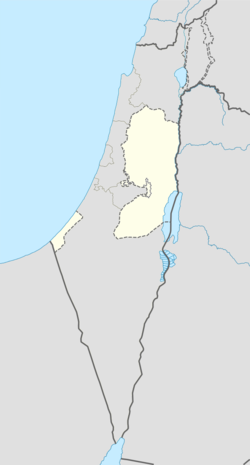Top Qs
Timeline
Chat
Perspective
Ein Qiniya
Local Development Committee in Ramallah and al-Bireh, State of Palestine From Wikipedia, the free encyclopedia
Remove ads
Ein Qiniya or 'Ayn Kiniya (Arabic: عين قينيا) is a Palestinian village in the northern West Bank, located 7 kilometers (4.3 mi) northwest of Ramallah and part of the Ramallah and al-Bireh Governorate of the State of Palestine. Ein Qiniya has existed since the Roman-era of rule in Palestine.[3] The village is very small with no public structures or institutions and is governed by a local development committee. Ein Qiniya is regionally notable for being a spring and autumn time picnic resort.[3]
There is an annual walk on March 4 from Ramallah to Ein Qiniyya in celebration of the spring.[4]
Remove ads
Location
'Ein Qiniya is located (horizontally) 5.5 km west of Ramallah. It is bordered by Ramallah to the east, Al-Zaitounah to the north, Al-Janiya and Deir Ibzi to the west, and Ein 'Arik and Beitunia to the south.[5]
Important Bird Area
A 1,500 ha site in the vicinity of the village has been recognised as an Important Bird Area (IBA) by BirdLife International because it supports a population of short-toed snake-eagles.[6]
Remove ads
History
Summarize
Perspective
A Middle Bronze Age tomb was discovered here in 1934.[7] Potsherds from the Hellenistic and Umayyad/Abbasid period have been found here.[7] Conder and Kitchener, from the Palestine Exploration Fund (PEF), suggested the identification of Ein Qinniya with En Gannim, mentioned by third-century writer Eusebius as a village near Bethel.[7]
Ein Qiniya has traditionally been identified with Ainqune of the Crusader era, one of the fiefs given by King Godfrey to the Church of the Holy Sepulchre.[8][9] However, Finkelstein writes that this identification should be reconsidered.[10] Potsherds from the Mamluk era have also been found here.[11]
During the Mamluk era, it was stipulated that the whole of the revenue from Ein Qiniya should go to the al-Tankiziyya in Jerusalem. The building was completed in 1328–29.[12]
Ottoman era
In 1517, the village was included in the Ottoman Empire with the rest of Palestine, and in the 1596 tax-records it appeared as Ayn Qinya, located in the Nahiya of Jabal Quds of the Liwa of Al-Quds. The population was 32 households, all Muslim. They paid a tax rate of 33.3% on agricultural products, which included wheat, barley, summer crops, olive trees, vineyards and fruit trees, occasional revenues, goats and beehives; a total of 4,760 akçe. 1/3 of the income went to a waqf.[13][14]
In 1838 it was noted as 'Ain Kinia, a Muslim village, located in the Beni Harith district, north of Jerusalem.[15]
An official Ottoman village list from about 1870 showed that Ain Kina had 54 houses and a population of 205, though the population count only included men.[16][17]
In 1882, the PEF's Survey of Western Palestine (SWP) described Ain Kanieh as "a village of moderate size on a ridge".[18]
In 1896 the population of 'Ain kinja was estimated to be about 135 persons.[19]
British Mandate era

In 1917, most of the village's inhabitants were evacuated by the British army on suspicion that residents killed a British officer. The residents were relocated to Beitunia and Yalo.[3] In the 1922 census of Palestine, conducted by the British Mandate authorities, 'Ain Qinia had a population of 56, all Muslims.[20] This had increased in the 1931 census to 83, still all Muslims, in a total of 26 houses.[21]
In the 1945 statistics the population was 100, all Muslims,[22] while the total land area was 2,494 dunams, according to an official land and population survey.[23] Of this, 1,276 were allocated for plantations and irrigable land, 569 for cereals,[24] while 19 dunams were classified as built-up (urban) areas.[25]
Jordanian era
In the wake of the 1948 Arab–Israeli War, and after the 1949 Armistice Agreements, Ein Qiniya came under Jordanian rule.
The Jordanian census of 1961 found 235 inhabitants.[26]
1967 and after

Since the Six-Day War in 1967 Ein Qiniya has been under Israeli occupation.
After the 1995 accords 12.1% of village land was classified as Area B, the remaining 87.9% as Area C.[27]
Israel has confiscated 157 dunams of village land in order to construct the Israeli settlement of Dolev.[28]
In 1982, residents numbered 101, then after a mass migration of other Palestinians to the Ein Qiniya, the population rose to 464 in 1984.[29] According to the Palestinian Central Bureau of Statistics, in 2006 it had a population of 807.[30] In the 2007 PCBS census, there were 817 people living in the village.[31] The village had a population of 721 by 2017.[1]
Remove ads
References
Bibliography
External links
Wikiwand - on
Seamless Wikipedia browsing. On steroids.
Remove ads



